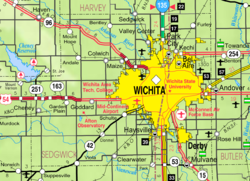Derby, Kansas
| Derby, Kansas | |
|---|---|
| City | |
 Location within Sedgwick County and Kansas |
|
 KDOT map of Sedgwick County (legend) |
|
| Coordinates: 37°33′9″N 97°15′41″W / 37.55250°N 97.26139°WCoordinates: 37°33′9″N 97°15′41″W / 37.55250°N 97.26139°W | |
| Country | United States |
| State | Kansas |
| County | Sedgwick |
| Platted | 1871 (El Paso) |
| Incorporated | 1903 (El Paso) |
| Renamed | 1956 (Derby) |
| Area | |
| • Total | 9.60 sq mi (24.86 km2) |
| • Land | 9.56 sq mi (24.76 km2) |
| • Water | 0.04 sq mi (0.10 km2) |
| Elevation | 1,293 ft (394 m) |
| Population (2010) | |
| • Total | 22,158 |
| • Estimate (2015) | 23,509 |
| • Density | 2,300/sq mi (890/km2) |
| Time zone | Central (CST) (UTC-6) |
| • Summer (DST) | CDT (UTC-5) |
| ZIP code | 67037 |
| Area code | 316 |
| FIPS code | 20-17800 |
| GNIS feature ID | 0474332 |
| Website | derbyweb.com |
Derby is a city in Sedgwick County, Kansas, United States and the largest suburb of Wichita. As of the 2010 census, the city population was 22,158.
For many millennia, the Great Plains of North America was inhabited by nomadic Native Americans. From the 16th century to 18th century, the Kingdom of France claimed ownership of large parts of North America. In 1762, after the French and Indian War, France secretly ceded New France to Spain, per the Treaty of Fontainebleau.
In 1802, Spain returned most of the land to France. In 1803, most of the land for modern day Kansas was acquired by the United States from France as part of the 828,000 square mile Louisiana Purchase for 2.83 cents per acre.
In 1854, the Kansas Territory was organized, then in 1861 Kansas became the 34th U.S. state. In 1867, Sedgwick County was established within the Kansas Territory, which included the land for modern day Derby.
In 1870, settlers John Haufbauer and J.H. Minich built the first houses, smithies, and general stores on the site that would become Derby. In 1871, the community was named El Paso, after El Paso, Illinois, and was laid out and platted. In 1880, the Atchison, Topeka and Santa Fe Railway changed the name of its rail station to Derby, after railroad official C. F. Derby, to avoid confusion with El Paso, Texas.
...
Wikipedia
